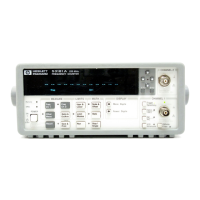Chapter 2 Operating Your Universal Counter
Using the Calibration Menu
Operating Guide 2-69
2
To Initiate the Calibration Routines
1 Press and hold Scale & Offset key, then cycle POWER key.
2 Unsecure for calibration by performing the preceding procedure.
3 Press Scale & Offset key until
CAL: OFFS1?
is displayed.
4 Press any one of the arrow keys until your calibration choice (that is,
CAL: OFFS2?
,
CAL: GAIN 1?
,
CAL: GAIN 2?
,
CAL: TI QUIK?
,
CAL: TI FINE?
, or
CAL: TIMEBAS?
) is displayed.
Note that the timebase choice (CAL: TIMEBAS?) only appears when a
Timebase Option is installed.
CAL:TI QUIK? and CAL:TI FINE? are two different ways to calibrate
out the differences in electrical path length between Channel 1 and
Channel 2. When you provide the calibration signal, the instrument
measures how the difference in path length translates to an average delay
between the two channels.
The Quick Time Interval Calibration requires a simple input signal.
You provide on Channel 1 a clean square wave with a rapid rise time and
an approximate frequency of 10 MHz. The instrument routes the
calibration signal in COMMON to both channels 1 and 2, and measures
the average delay between the two channels so configured. The advantage
of the Quick Calibration is that it is easy, quick, and requires little special
equipment. The disadvantage is that the calibration term is best fit for
TI measurements configured COMMON and measured from rising to
rising edge; it leaves uncorrected a small systematic error for all other
configurations. The Fine Time Interval Calibration minimizes systematic
error by calibrating the instrument in each configuration.
The Fine Time Interval Calibration requires a special calibrator signal
source to provide input—because it produces eight calibration terms, each
tailored to a different combination of input conditions. It requires the
synthesizer driving the calibrator to produce a very accurate 10 MHz
waveform—because it calibrates the pulse width configuration against the
50-nanosecond pulse width so provided. It minimizes systematic error by
calibrating the instrument in each of the eight configurations: falling to
falling edges, falling to rising edges, etc., and both SEPARATE and
COMMON routing.

